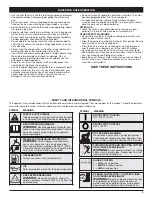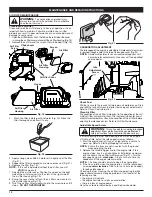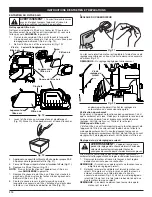
12
REPLACING THE SPARK PLUG
Use a replacement part #
753-05784
or Champion ref. #
RDZ4H
.
The correct spark gap is
0.025 in. (0.635 mm)
. Remove the plug
after every 25 hours of operation and check its condition.
1.
Stop the engine and allow it to cool. Grasp the plug wire
firmly and pull the cap from the spark plug.
2.
Clean dirt from around the
spark plug. Remove the
spark plug from the
cylinder head by turning it
counterclockwise with a
5/8” socket.
3.
Replace cracked, fouled or
dirty spark plug. Set the air
gap at 0.025 in. (0.635 mm)
using a feeler gauge (Fig.
28).
4.
Install a correctly-gapped
spark plug in the cylinder
head. Turn the 5/8 in.
socket clockwise until snug.
If using a torque wrench torque to:
110-120 in.•lb. (12.3-13.5 N•m)
Do not over tighten.
Fig. 29
SPARK ARRESTOR MAINTENANCE
1.
Remove the muffler cover. See
Rocker Arm Clearance
.
2.
With a flat blade screwdriver or Torx T-20 bit, remove the screw
attaching the spark arrestor cover to the muffler (Fig. 29).
3.
Remove the spark arrestor cover.
4.
Remove the spark arrestor screen from the spark arrestor
cover.
5.
Clean the spark arrestor screen with a wire brush or
replace it.
6.
Reinstall the spark arrestor screen, spark arrestor cover
and screw.
CLEANING THE UNIT
• Use a small brush to clean off the outside of the unit and to
keep the air vents free of obstructions.
• Do not use strong detergents or petroleum based cleaners,
such as kerosene. Some household cleaners contain aromatic
oils such as pine and lemon that can damage the plastic
housings or handles. Wipe off any moisture with a soft cloth.
STORAGE
• Never store the unit with fuel in the tank where fumes may
reach an open flame or spark.
• Allow the engine to cool before storing.
• Store the unit in a locked up area to prevent
unauthorized use or damage.
• Store the unit in a dry, well-ventilated area. Do not store next
to corrosive material like fertilizer.
• Store the unit out of the reach of children.
LONG-TERM STORAGE
If the unit will be stored for an extended time:
1.
Carefully drain all gasoline from the fuel tank by removing
the fuel cap and tipping the motor housing over to allow
the fuel to drain into an approved gas container. Do not
use gas that has been stored for more than 60 days.
Dispose of the old gasoline in accordance with Federal,
State and Local regulations.
2.
Start the engine and allow it to run until it stalls. This
ensures that all gasoline has been drained from the
carburetor.
3.
Allow the engine to cool. Remove the spark plug and put 5
drops of high quality motor oil into the cylinder. Pull the
starter rope slowly to distribute the oil. Reinstall the spark
plug.
NOTE:
Remove the spark plug and drain all of the oil from the
cylinder before attempting to start the unit after
storage.
4.
Change the oil, referring to the
Changing the Oil
section.
Dispose of the old oil in accordance with Federal, State
and Local regulations.
5.
Thoroughly clean the unit and inspect for any loose or
damaged parts. Repair or replace damaged parts and
tighten loose screws, nuts or bolts.
6.
To take up less storage area, loosen the handlebar knobs
and fold the handlebar down. The unit is ready for storage.
TRANSPORTING
• Allow the engine to cool before transporting.
• Secure the unit while transporting.
• Drain the fuel tank before transporting.
• Tighten fuel cap before transporting.
MAINTENANCE AND REPAIR INSTRUCTIONS
10. Reinstall the rocker arm cover using a new gasket. Torque
the screw to 20–30 in•lb (2.2–3.4 N•m).
11. Reinstall the engine cover. Check alignment of the cover
before tightening the screws. Tighten screws.
12. Check the spark plug and reinstall. See Replacing the
Spark Plug.
13. Replace the spark plug wire.
WARNING:
To avoid serious personal injury,
always turn the unit off and allow it to cool before
you clean or perform any maintenance on it.
WARNING:
Do not sand blast, scrape or clean
electrodes. Grit in the engine could damage the
cylinder.
0.025 in.
(0.635 mm)
Fig. 28
Muffler
Spark Arrestor Screen
Spark Arrestor Cover
Screw













































